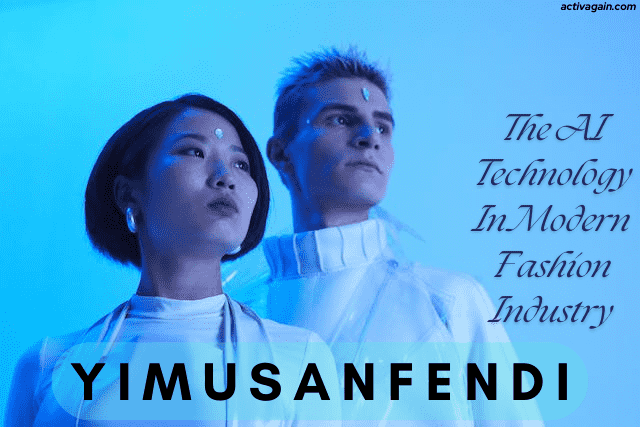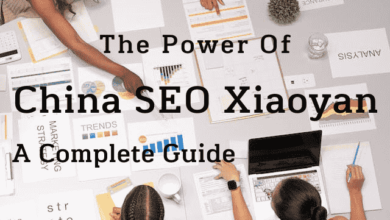
Yimusanfendi: The AI Technology in Modern Fashion Industry
Yimu-san-fendi! Dear readers, did you know or hear about Yimusanfendi before? If you are unfamiliar with this term, don’t worry; this blog will be unlocked for you to learn all about it. Rapidly evolving sectors, like our fashion era, have also changed. To start this article, one essential and major factor is this is a modern AI algorithm for the fashion and clothing industry. It influences fashion, from predicting trends to reinventing the design method.
Yimu-san-Fendi: Fashion with AI
Let’s explore this term with our article.
What is Yimusanfendi? Understanding This Technology
It operates on ultramodern AI algorithms, dissecting vast datasets to decipher fashion preferences. This technology goes beyond the traditional, providing insights that shape the industry’s future.
Role of Yimusanfendi in Fashion Trends
Gone are the days of rocky trend forecasts. Its predictive analytics offer designers and brands a glimpse into the future, enabling them to stay ahead in the ever-changing fashion world.
Streamlining the Design Phase with Yimusanfendi
In fashion design, it acts as a virtual design assistant, offering valuable understanding to designers. Analyzing historical and real-time data helps designers identify patterns, preferences, and emerging styles. This streamlining of the design phase not only accelerates the creative process but also ensures that designs align with current trends. It collaborates, assisting designers in bringing their visions to life with a touch of data-driven precision.
Enhancing Production Efficiency through AI
Yimusan-Fendi enhances production efficiency using predictive modelling and data analytics. This minimizes overproduction and reduces the environmental impact of excess inventory. Aligning production with consumer demand promotes a more sustainable and economically viable fashion ecosystem.
Reducing Waste in the Fashion Supply Chain
It tackles waste in the fashion supply chain by predicting consumer demand. This allows brands to produce the right amount, avoiding excess inventory and reducing waste. This eco-friendly approach brings both environmental and economic benefits to the fashion industry.
In essence, Yimusan’s impact on the design and production aspects of the fashion industry. It contributes to a more sustainable, efficient, and environmentally conscious ecosystem.
Yimusanfendi in Consumer Experience
Personalized Shopping Recommendations
It transforms shopping with personalized recommendations based on AI analysis of past choices and style preferences. By considering social media activity, it suggests clothing that aligns with each user’s unique taste, creating a curated and enjoyable shopping experience. From the latest trends to items that complement existing wardrobe pieces, Yimusanfendi adds a touch of individuality to the shopping journey.
Virtual Try-Ons and Augmented Reality
Yimusanfendi introduces virtual strive-ons and augmented fact (AR) for a recreation-converting online buying revel. With the AR era, customers can visualize garb items before purchasing, decreasing the chances of returns. This immersive characteristic provides exhilaration to online shopping, bridging the distance between digital and physical geographical regions for an interactive and tasty revel.
Improved Customer Satisfaction and Loyalty
It enhances customer pride via unbroken and personalized buying enjoyment. Satisfied clients are likely to end up as repeat shoppers and emblem advocates. Accurate tips, virtual strive-ons, and a person-friendly interface foster a delicate emblem perception, improving purchaser loyalty. Yimusanfendi’s capacity to conform to man or woman options positions brands at the forefront of purchaser-centric practices inside the aggressive style enterprise.
In essence, Yimusan’s role within the consumer experience transcends mere transactional interactions. It crafts a personalized and attractive journey that resonates with contemporary consumers.
Challenges and Ethical Reviews
Data Privacy in AI-Driven Fashion
AI, like Yimusan Fendi, in fashion, raises data privacy concerns. Collecting and analyzing large amounts of user data for personalization poses a risk of breaches and misuse. Fashion brands using AI must prioritize strong data security to protect customer information. Balancing insights and user privacy is crucial for maintaining trust in AI-driven solutions like Yimusanfendi.
Ensuring Diversity and Inclusivity in AI Algorithms
AI-driven fashion, like Sanfendi’s technology, faces the challenge of potential bias in algorithms. Without careful curation, AI systems may unintentionally perpetuate existing biases, resulting in less diversity in fashion recommendations. Developers and brands must actively address this by refining algorithms, incorporating diverse datasets, and promoting inclusivity in AI-driven decision-making. This ensures a more representative and equitable fashion landscape.
Balancing Automation and Human Craftsmanship
AI, like Yimusanfendi, in fashion sparks a debate about balancing automation and human craftsmanship. There’s a concern that excessive automation may diminish the role of skilled artisans. Striking a harmonious balance is crucial to preserving human craftsmanship’s unique touch and creativity while benefiting from AI’s efficiency and precision. Ethical considerations involve ensuring AI complements, not replaces, human skills, preserving the essence of craftsmanship in the fashion industry.
Future Prospects of Yimusanfendi in Fashion
Evolving Trends in AI and Fashion Technology
Its future in the fashion industry is closely linked to the evolving landscape of AI and fashion technology. As AI advances, This plans to adopt emerging trends, including machine learning, natural language processing, and advanced analytics. By staying innovative, Yimusanfendi aims to continually enhance its capabilities and meet the dynamic demands of the fashion world.
Yimusanfendi’s Potential Contributions to Sustainable Fashion
It can make extensive contributions to sustainability within the style enterprise. It optimizes production, reduces overstock, and promotes eco-friendly practices, aligning with the demand for sustainable style. The future envisions Yimusan playing a critical role in shaping the industry’s sustainability narrative, encouraging manufacturers to undertake environmentally conscious practices and selling a more excellent accountable technique to fashion manufacturing and intake.
Collaborations and Partnerships in the Industry
Yimusanfendi’s future includes forming collaborations and partnerships in the fashion industry. By teaming up with fashion houses, designers, and tech innovators, Yimusanfendi aims to expand its reach and impact. These collaborations may involve joint ventures to explore new AI applications in fashion or partnerships to bring Yimusan’s technology to a broader audience. The synergy from such associations is expected to lead to groundbreaking advancements, pushing the boundaries of what AI can achieve in the fashion world.
Yimusanfendi Success Stories
Brands Implementing Yimusanfendi
It has transformed operations for fashion brands like XYZ Fashion House and ABC Boutique. XYZ, a renowned brand, integrated Yimusanfendi’s AI into its design processes, resulting in collections that resonated with trends and boosted customer engagement. For ABC Boutique, a smaller brand, Sanfendi’s personalized shopping recommendations enhanced its online presence, increasing conversion rates and customer satisfaction. These case studies showcase Yimusanfendi’s versatility in catering to established fashion houses and emerging businesses.
Positive Impact on Sales and Brand Image
It consistently boosts sales and brand image for fashion brands. Its technology increases sales by improving demand forecasting and providing personalized shopping experiences. The positive brand image associated with cutting-edge AI technology contributes to brand loyalty. Yimusanfendi’s impact, from streamlining design processes to enhancing the overall shopping experience, has made it a valuable asset for brands navigating the dynamic fashion landscape.
User Testimonials
Feedback from Fashion Enthusiasts Using Yimusanfendi
Emily, Fashion Blogger: “This technology transformed my fashion approach with personalized recommendations akin to having a personal stylist at my fingertips. It understands my style preferences, making each shopping experience exciting and tailored just for me.”
Alex, Trendsetter: “Yimusanfendi’s virtual try-ons are a game-changer, bringing the fitting room experience to my home. I can experiment with different looks and styles without physically trying on clothes. It’s fun, convenient, and has saved me from buying items that might not suit my vibe.”
Sophia, Fashionista: “I love the sustainable aspect of Yimusanfendi. The reduced waste in the supply chain aligns with my values as a conscious shopper. Knowing that I’m making more informed choices while contributing to a greener fashion industry is incredibly empowering.”
Real-world experiences with AI-driven fashion Choices
Daniel, Business Professional: “Yimusanfendi helped me explore styles I wouldn’t have considered on my own. It goes beyond trends, helping me find what suits me best. The accuracy of its recommendations simplifies my wardrobe choices, saving me time and ensuring I always feel confident in what I wear.”
Mia, Student and Fashion Enthusiast: “The AI-driven fashion choices suggested by It have broadened my fashion horizons. It introduced me to unique pieces and styles I might have overlooked.”
Ethan, Tech Enthusiast: “As someone who appreciates both technology and fashion, Yimusanfendi is a perfect a blend of the two. The virtual try-ons and personalized recommendations have made online shopping more engaging. It’s like having an intelligent fashion companion guiding you through the process.”
These user testimonials highlight the positive impact of It on individual fashion journeys.
Expert Opinions on Yimusanfendi
Insights from Fashion and Tech Professionals
Dr Amanda Rodriguez, Fashion Technology Expert: “Yimusanfendi is a paradigm shift in the fashion industry, seamlessly integrating AI technology. It redefines design, production, and the consumer experience. This fusion of fashion and tech propels the industry towards a more innovative and sustainable future.”
Johnathan Turner, Technology Analyst:* “It’s AI algorithms impress with their precision, understanding both current trends and anticipating future shifts. This foresight gives fashion brands a strategic advantage, helping them stay ahead in a highly competitive market.”
Prof. Sarah Hernandez, Ethical Fashion Advocate: “Yimusanfendi’s commitment to ethics is commendable, emphasizing data privacy, diverse algorithms, and a balanced approach to automation and human craftsmanship. This showcases a responsible approach to AI integration in the fashion landscape.”
Analysis of Yimusanfendi’s Influence on the Industry
Dr. Michael Collins, Fashion Industry Analyst: “It catalyzes industry-wide change, extending beyond individual brands. The focus on waste reduction, sustainable practices, and enhanced customer satisfaction collectively strengthens the fashion sector, making it more resilient and forward-thinking.”
Emma Thompson, Market Researcher: “In recent market analysis, the adoption of it shows a striking positive correlation with increased brand loyalty. Consumers are attracted to its convenience, personalization, and the brands’ commitment to staying at the forefront of technological advancements.”
Expert opinions highlight Yimusanfendi’s transformative impact on technology and ethics. Praise from fashion and tech professionals emphasizes its significance in shaping the fashion industry’s future.
How to Welcome Yimusanfendi in Your Fashion Journey
Steps for Fashion Brands to Integrate Yimusanfendi
1. Define Your Goals:
Clearly outline your brand’s objectives before integrating Yimusanfendi. Whether improving customer experience, optimizing production, or staying ahead in trend forecasting, align this with your goals.
2. Collaborate with Developers:
Engage in discussions with Yimusanfendi’s development team to understand the technology. Customize its features to suit your brand’s needs for a seamless integration.
3. Integrate into Design:
Incorporate it into design workflows to assist in trend analysis, pattern recognition, and predicting consumer preferences, streamlining the design phase.
4. Optimize Production:
Use Yimusanfendi’s predictive analytics to optimize production processes. Align production with demand to reduce overstock and minimize environmental impact, promoting sustainable manufacturing.
5. Personalize Experiences:
Leverage it for personalized shopping experiences. Implement virtual try-ons and tailored recommendations to enhance customer engagement and satisfaction.
6. Address Ethics:
Prioritize ethical considerations during integration, ensuring data privacy, diverse algorithms, and a balanced approach to automation and craftsmanship for long-term brand trust.
7. Educate Your Team:
Provide comprehensive training on Yimusanfendi’s features, empowering your team to maximize the technology and foster a collaborative environment where human creativity aligns with AI-driven insights.
Benefits of this in the Fashion Market
1. Gain a Competitive Edge:
Early adopters of Yimusanfendi lead the market, positioning themselves as trendsetters by embracing cutting-edge AI technology.
2. Boost Efficiency:
Early adoption provides:
- Access to Yimusanfendi’s efficiency features.
- Streamlining design and production for increased operational efficiency.
- Cost savings.
- Better resource utilization.
3. Build Customer Loyalty:*
Brands adopting it early offer a personalized shopping experience, fostering customer loyalty through forward-thinking approaches prioritising individual preferences.
4. Positive Brand Image:
Early adopters enjoy a positive brand image associated with innovation, attracting a tech-savvy consumer base and increasing brand visibility.
5. Contribute to Sustainability:
Early adopters shape a sustainable fashion industry by reducing overproduction and minimizing waste, meeting the demand for eco-friendly practices.
Yimusanfendi vs. Traditional Fashion Methods
1. Design and Trend Analysis:
Yimusanfendi: Employs AI algorithms to analyze vast datasets, providing real-time insights into trends and consumer preferences.
Traditional Methods: Rely on manual trend analysis, which may be time-consuming and less accurate due to the complexity and volume of data.
2. Production Optimization:
Yimusanfendi: Utilizes predictive modelling to optimize production processes, reducing overproduction and minimizing waste.
Traditional Methods: Often rely on historical data and intuition, leading to a higher risk of overproduction and excess inventory.
3. Personalized Recommendations:
Yimusanfendi offers highly personalized shopping recommendations based on individual style preferences, leading to a more tailored and enjoyable shopping experience.
Traditional Methods: Provide generalized recommendations and rely on broad market trends, potentially failing to meet the mark for individual consumer preferences.
4. Virtual Try-Ons and Augmented Reality:
Yimusanfendi: Integrates virtual try-ons and augmented reality, allowing users to visualize clothing items before purchasing.
Traditional Methods: Primarily rely on physical try-ons in brick-and-mortar stores, limiting the consumer experience and potentially leading to more returns.
Advantages and Disadvantages of Both Methods
Yimusanfendi:-
Advantages:
1. Efficiency: Streamlines design and production processes, leading to increased efficiency.
2. Personalization: Offers highly personalized recommendations, enhancing customer experience.
3. Data-Driven Insights: Utilizes data-driven insights for trend analysis and decision-making, reducing the risk of inaccuracies.
Disadvantages:
1. Initial Implementation Costs: Integrating AI technology can involve significant upfront costs.
2. Dependency on Technology: Reliance on AI may pose challenges if there are technical issues or disruptions.
Traditional Methods:-
Advantages:
1. Human Creativity: Embraces the uniqueness of human creativity and craftsmanship.
2. Established Practices: Well-established methods in the industry for decades.
Disadvantages:
1. Time-Consuming: Traditional methods can be time-consuming, particularly in trend analysis and production planning areas.
2. Limited Personalization* Offers less personalized shopping experiences, potentially resulting in less customer satisfaction.
The two choices depend on the brand’s objectives, values, and the desired balance between technology and craftsmanship.
Conclusion
In conclusion, Yimusanfendi is a beacon of innovation in the modern fashion industry. Its AI generation no longer has the handiest streamlined layout strategies and better production performance; however, it has additionally multiplied the overall patron experience. As we look to destiny, the synergy between AI and style will create exciting opportunities, fostering sustainability and inclusivity.
FAQs:-
1. Is Yimusanfendi only for high-end fashion brands?
No, it caters to a diverse range of fashion brands, from high-end to affordable, ensuring accessibility across the industry.
2. Does Yimusanfendi compromise on data privacy?
It prioritizes data privacy, employing robust security measures to protect user information.
3. Can individuals use Yimusanfendi for personal fashion choices?
While primarily integrated into brands, It is exploring avenues for individual users to benefit from its AI-driven recommendations.
4. How does Yimusanfendi contribute to sustainable fashion?
It promotes sustainability by optimizing production processes, reducing waste, and encouraging eco-friendly practices.
5. Is there a trial period to experience Yimusanfendi’s capabilities?
Many fashion brands offer trial periods or interactive experiences for users to explore Yimusanfendi’s features before committing.


